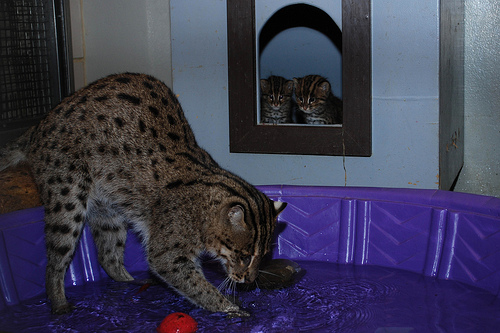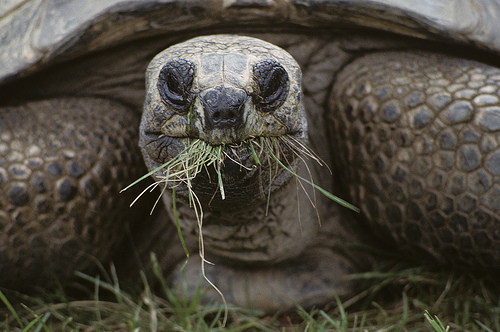Image description: Electra, the National Zoo’s newest fishing cat mom, teaches her two babies how to fish for food.
Electra gave birth to the kittens on May 18. It was the first time fishing cats have been bred at the National Zoo.
Photo by the National Zoo.
Image description:
From the National Zoo:
The Smithsonian’s National Zoo recently oversaw the births of two fishing cats, one of Asia’s most elusive species. The kittens were born between 9 a.m. and 4 p.m. May 18 in an off-exhibit den. Their birth marks an important milestone: this is the first time fishing cats have successfully bred and produced young at the National Zoo.
Learn more about the birth of the fishing cats.
Picture from the National Zoo.
Image description: Two new cheetah cubs, pictured here at 2 and 16 days of age, were born earlier this month at the Smithsonian National Zoo’s Conservation Biology Institute in Front Royal, Virginia. The cubs, valuable additions to the dwindling genetic pool of this endangered species, should make their debut at the Zoo in late summer. But first, they had to survive a harrowing birth experience.
Five-year-old cheetah and first-time mom Ally gave birth to the first cub, a male, April 23. However, instead of nursing and cleaning the cub, she abandoned him, relatively common behavior for first-time mothers under human care.
Cheetah keepers moved the cub to the veterinary hospital to be treated for severe hypothermia. When Ally suddenly stopped having contractions hours later, vets anesthetized her to see if she had additional cubs. Additional heartbeats were heard, and a radiograph determined that three cubs remained.
Vets performed a cesarean section, a procedure rarely used on cheetahs and one that cubs do not often survive. A team of veterinarians, keepers and scientists worked for three hours to resuscitate the three cubs, performing CPR, administrating medications, and rubbing the cubs to dry and warm them. One of the three cubs, a female, did survive.
Both cubs and their mother were in intensive care for the following three days. The cubs’ father, Caprivi, was brought to the veterinary hospital to donate plasma to the cubs to boost their immune systems. Today both cubs and their mother appear to be in good health, though animal care staff is continuing to monitor all three carefully.
Check out more images and news about the cubs.
Image description: Picasso or Panda? Giant panda Tian Tian gets his paws dirty with non-toxic water-based paint at the National Zoo. Painting is one among many activities that fall under Animal Enrichment—a program that provides physically and mentally stimulating activities and environments for the Zoo’s residents.
Art produced by many of the Zoo’s mammal and bird residents will be available for purchase at the National Capital chapter of the American Association of Zoo Keepers (AAZK) Art Show, which will take place spring 2012.
Photo by Smithsonian’s National Zoo
Image description: An Aldabra tortoise eats some grass at the National Zoo, in Washington, D.C.
Photo by Jessie Cohen, Smithsonian’s National Zoo.




